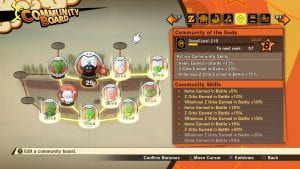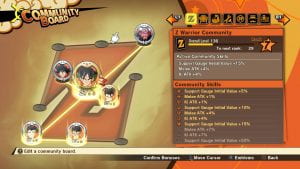Originally, this post was going to be an exploration of Dragon Ball Z: Kakarot as a JRPG—and I guess it’s not…not that, in some ways—but then I finally finished the Kakarot main story and thought it would be a good time to reflect on what 75~ hours of gameplay showed me. And I really, really wish Steam gave me a breakdown of hours spent actively playing, hours spent leaving the game running by accident, and hours spent watching cutscenes. If the latter isn’t the highest total—maybe it comes second to idle time—I’d be genuinely shocked. Don’t get me wrong: I loved playing Kakarot and it gave me all the things I had hoped for: endless enemies reflecting the danger-magnet that is Akira Toriyama’s Earth, a huge and accessible map, a painstakingly detailed playthrough of the DBZ narrative, and highly detailed systems for training, cooking, economy, friendship, and looting/collecting. This, coupled with straight-up silly or damn weird elements like a timed robo-walker mini-game (because why not?), or Goku’s inexplicable Saiyan tail that he reattaches when fishing, makes Kakarot a ton of fun.
For me, a lot of the fun in an RPG stems from its difficulty, and from its sheer breadth or scope. Unreasonably large map with detailed exploration mechanics? Count me in. But in spite of its huge map and all its complex systems, Kakarot isn’t…challenging. As a player, I often run into the issue of being severely over-leveled as I face challenges because I genuinely enjoy grinding and exploring the world of the game as I explore the game’s narrative. So, in games like Kakarot that give you XP for almost anything, that adds up to a serious level gap pretty quickly. In the closing hours of the game, my main squad of Goku, Gohan, and Vegeta were all 15 levels above the main story enemies. Without level scaling, where the game’s enemies mimic the player’s growth thereby growing with the player, my final fight against Kid Buu lasted about three minutes and took almost no effort. It was clear that the enemy was meant to be difficult: disruptive cutscenes emphasized Buu’s power, he had a super attack at the ready almost constantly, and his attack pattern was more complex than previous enemies. However, the battle was a breeze and it felt horribly incongruous with the grueling narrative taking place between these cheeky fights. In-between short boss fights, long cutscenes showed Buu killing off the remaining living beings on Earth. While this wasn’t depicted in gruesome detail, it’s par for the course of Dragon Ball that the stakes for these boss fights are planetary life or death. (Don’t even get me started on the climate narrative.) These scenes perform a level of difficulty that the game itself doesn’t supply, exacerbating an existing feeling of discontinuity within the game.
All this to say, Kakarot is an exercise in the grind. It rewards ridiculously detailed and attentive play. As someone who loves hitting 100% completion on games, I’m all about that grind. However, it isn’t rewarding when the game doesn’t grind with you, so to speak. It offers you so many avenues to gain XP and level up in disparate ways (e.g. your character’s level as a fighter is totally different from their level as a “friend” or “community board” member) that it’s easy to out-grind the game by paying even minor attention to these systems.
As an example, Kakarot has a ridiculously complex friendship and gifting system (see the images below). As you progress through the main story, you earn “Soul Emblems” for characters, which you can then add to a “Community Board.” These Emblems represent characters who each have “proficiencies” (skills, basically) across different categories. Each Community Board reflects one of these proficiencies. While completing quests in the world and gathering soul emblems, players hoard a TON of items—stuff for monetary value, for consumption, and for gifting. Gifts have different values and players “give” these gifts to characters to improve their friendship with that character, which in turn increases the level of whatever Community Board you’ve placed that character in. These levels provide a wide variety of scaffolding in-game advantages, like permanent item effects or other buffs.
- Gallery of Soul Emblems. Each of these emblems has three levels with rewards for reaching each of them, based on their proficiencies across a bunch of different skills, and your “friendship” with that character.
- Community Board: Community of the Gods. Each of these emblems represents a character encountered (and “collected”) in the game. The number under their name is generated by their “friendship level” and any partner bonuses based on how you lay out the emblems in the community board.
- Community Board: Z Warrior Community. Each of these emblems represents a character encountered (and “collected”) in the game. The number under their name is generated by their “friendship level” and any partner bonuses based on how you lay out the emblems in the community board.
- This is what the individual Soul Emblem screen looks like. As you can see, I’m BFFs with Goku after a lot of time and effort.
In other words, this is a super complex system that requires significant attention and effort to maximize (which isn’t very fun, mind you, because the Soul Emblems/Community Board systems are set up like inventory management). It was way too late in the game that I realized that my efficiency in using detailed systems like friendship/gifting had been exacerbating the very advantages that made the battle sequences of the game somewhat disappointing. What I came away with here was a sense of dissonance. I genuinely enjoyed the game as a whole because it delivered things I had expected, but it also let me down in unexpected ways. As a player, I felt that working with the systems provided to me in this massive JRPG undercut the rigor of the game’s fighting sequences in conflict with the story. The push for self-improvement is one of the main themes of Dragon Ball, yet Kakarot, as a playable version of that story, performs difficulty without allowing the player to perform that same level of difficulty themselves.





There is always that interesting balance to strike for these kinds of games where the difficulty slow scales down the more the player-character levels up. A designer wants to reward the player for playing the game and investing in their character, but they want the game to be difficult. The problem is, at what point does the player *have* to grind to overcome the obstacle? And is that an appropriate way to structure the game? I’ve often found in this kind of game (JRPGs in particular) struggle with this problem because if the power of the player-character and the difficulty are linked, then grinding feels meaningless, but if they are detached from each other the game’s balance can feel wonky. It’s interesting that a game like Kakarot would struggle so much with this issue, considering that the entire series is about fighting and improvement, so you’d think that they’d put a lot of thought into developing systems that match the series’s thematic content.
There’s also so much visual information here that it can be difficult to parse out what everything really means or how it functions, a struggle that many big budget games have today.
Thank you both for your comments! I think the question of when, how, and why players *have* to grind to overcome a particular obstacle in a game is really useful food for thought. Especially in cases like what David described, which is totally true for Kakarot. The animations and interface can sometimes be really overwhelming and makes more sense once it has been compartmentalized. For example, the gifting system I described only really made sense after I spent like 20 minutes messing around with it and giving characters gifts. The ‘rewards’ you get for friendship levels (each character’s “emblem” has three levels with a one-time reward that you can earn as you become better friends with them) aren’t…particularly helpful and they’re more collectibles which soothes my completionist heart. When collector systems like ‘gifting’ and ‘friendship’ scaffold into in-game systems like item, battle, and exploration buffs, it takes that much more work to understand the game’s systems. In this case, it was worth it because as a player, I don’t mind grinding to maximize my play, but the amount of detailed work necessary to do that doesn’t feel rewarding. This might be addressed by making the process of learning the systems a bit more robust or by scaling the systems down (because yikes they’re extensive–each “community board” has like 10 levels of perks you can unlock to customize your play).